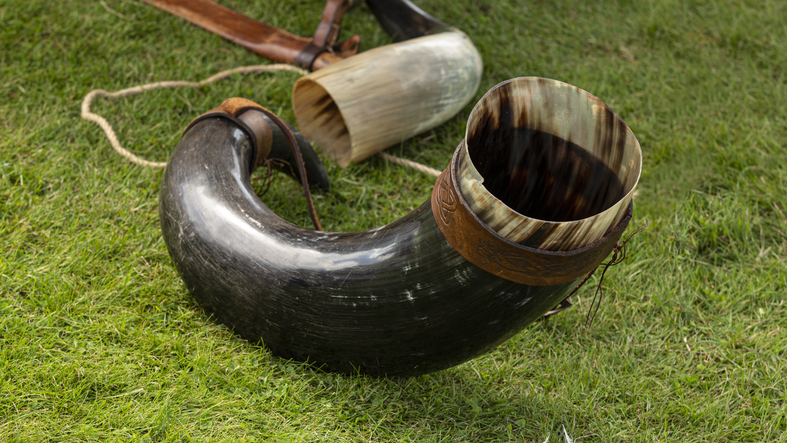The ideal cup for imbibing any type of alcohol depends on many factors ranging from the aroma, style of the brew, to how the weight of the cup feels in your hand. As you guys know, the taste, nose, and mouthfeel will differ greatly from one mead to another. From light and sparkling to heavy and still, meads can be earthy, flowery, savory, or sweet. Mead is so delicious that we could drink it from our shoes and still love it, but a good cup honors the ancient beverage’s rich history and nuanced flavors while enhancing the whole mead drinking experience.
The Art of Mead Consumption
Mead, often referred to as the “nectar of the gods,” is one of the oldest known alcoholic beverages, with a history that spans thousands of years. This storied drink, made from fermenting honey with water, sometimes with fruits, spices, grains, or hops, has a rich cultural heritage that deserves to be honored with every sip. For the modern mead enthusiast, history buff, and craft beverage lover, understanding and appreciating traditional mead drinking vessels can elevate the entire experience.
The Historical Significance of Mead Vessels
Historically, mead has been enjoyed in various types of vessels, each reflecting the culture and era from which it originated. These vessels not only served a practical purpose but also symbolized status, craftsmanship, and the communal aspect of mead drinking. Let’s explore some of the most iconic traditional mead drinking vessels:
1. The Horn of Plenty: The Viking Drinking Horn
One of the most iconic and visually striking mead vessels is the Viking drinking horn. Made from the horns of cattle, these vessels were commonly used by the Norse and other early Germanic peoples.
- Aesthetics and Craftsmanship: Drinking horns are often ornately carved or adorned with metal fittings, showcasing the craftsmanship of the artisans.
- Practicality: The natural curvature of the horn allows for a comfortable grip, but it’s worth noting that these vessels cannot be set down unless they come with a stand.
- Cultural Significance: Drinking horns symbolize bravery and camaraderie, often used in ceremonies and celebrations.
2. The Earthen Mug: Medieval Stoneware
In medieval Europe, stoneware mugs and jugs were common vessels for enjoying mead. These earthen mugs were robust and often featured intricate designs or glazes.
- Durability: Stoneware is known for its durability and ability to retain temperature, keeping your mead at an ideal drinking temperature.
- Designs: These vessels often featured elaborate designs, from simple glazes to detailed carvings depicting scenes of daily life or mythology.
- Communal Aspect: Stoneware mugs were often used in communal settings such as feasts and gatherings, emphasizing the social nature of mead drinking.
3. The Elegant Chalice: Medieval and Renaissance Goblets
Chalices and goblets made of metal or glass were popular during the medieval and Renaissance periods. These elegant vessels were often used by the nobility and upper classes.
- Elegance and Prestige: Chalices and goblets were symbols of wealth and status, often made from precious metals like silver or adorned with gemstones.
- Functionality: The wide bowl of the chalice allows for better aeration, enhancing the aroma and flavor of the mead.
- Ceremonial Use: These vessels were often used in religious or ceremonial contexts, adding a sense of reverence to the mead drinking experience.
Modern Interpretations: Bringing Tradition to Today
While traditional mead vessels are steeped in history and cultural significance, modern interpretations can offer a blend of old-world charm and contemporary practicality. Here are some ways you can enjoy mead today while paying homage to its rich heritage:
1. Handcrafted Horn Mugs
Modern artisans create handcrafted horn mugs that combine the visual appeal of traditional drinking horns with the practicality of a flat base. These vessels are often polished and treated to be food-safe, allowing you to enjoy your mead without worrying about spills.
2. Ceramic Tankards
Ceramic tankards offer a nod to the medieval stoneware mugs while providing modern-day benefits such as insulation and dishwasher safety. These vessels often feature intricate designs and glazes that reflect traditional artistry.
3. Glass Goblets and Chalices
For those who prefer the elegance of a chalice, glass goblets offer a contemporary twist. These vessels are designed to enhance the drinking experience by showcasing the color and clarity of the mead, while their shapes are optimized for aroma and flavor.
4. Wooden Drinking Cups
Wooden drinking cups harken back to ancient times when mead was enjoyed from carved wooden vessels. Modern versions are often crafted from sustainably sourced wood and treated with food-safe finishes, combining rustic charm with practicality.
Choosing the Right Vessel: Factors to Consider
When selecting a mead drinking vessel, consider the following factors to ensure you get the most out of your mead drinking experience:
- Aroma: A wider bowl allows for better aeration, enhancing the aroma of the mead.
- Temperature: Materials like ceramic and stoneware retain temperature well, keeping your mead at an ideal drinking temperature.
- Comfort: The weight and shape of the vessel should feel comfortable in your hand, allowing you to enjoy your mead leisurely.
- Aesthetic Appeal: Choose a vessel that reflects your personal taste and pays homage to the rich history of mead drinking.
Elevate Your Mead Drinking Experience
Mead is more than just a beverage; it’s a connection to ancient traditions and a journey through history. By choosing the right vessel, you can enhance your appreciation of this timeless drink and elevate your mead drinking experience.
Whether you prefer the rustic charm of a Viking horn, the durability of a stoneware mug, the elegance of a chalice, or the modern practicality of a glass goblet, there’s a mead drinking vessel that’s perfect for you.
Embrace the past, celebrate the present, and toast to the future of mead drinking. Cheers!
—
Interested in learning more about mead and its rich history? Follow our blog for more insights, tips, and stories from the world of craft beverages. Share your favorite mead drinking vessel in the comments below!

